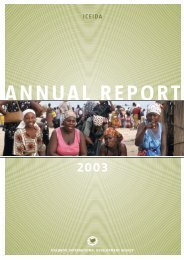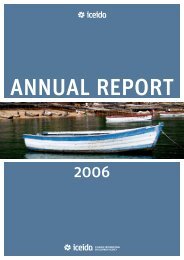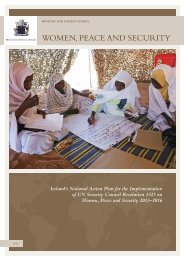Mangochi-ICEIDA-Partnership-in-Public-Health-2012-2016-Part-II ...
Mangochi-ICEIDA-Partnership-in-Public-Health-2012-2016-Part-II ...
Mangochi-ICEIDA-Partnership-in-Public-Health-2012-2016-Part-II ...
Create successful ePaper yourself
Turn your PDF publications into a flip-book with our unique Google optimized e-Paper software.
MANGOCHI <strong>ICEIDA</strong> PARTNERSHIP IN PUBLIC HEALTH – PROGRAMME DOCUMENT <strong>2012</strong>-<strong>2016</strong><br />
76.4% of children 12-23 months of age were fully immunised (national average 80.9%). The HMIS<br />
reported 71% immunisation coverage <strong>in</strong> <strong>Mangochi</strong> (fully immunised at 1 year) for the f<strong>in</strong>ancial year<br />
2010/2011 (72% <strong>in</strong> 2009/2010). HSAs play a role <strong>in</strong> immunisation.<br />
Integrated Management of Childhood Illnesses (IMCI) is another pillar of a child survival strategy. The<br />
ma<strong>in</strong> causes of disease and death <strong>in</strong> young children are diarrhoea, acute respiratory <strong>in</strong>fections (ARI)<br />
and malaria. Reported scores for care seek<strong>in</strong>g <strong>in</strong> childhood illnesses and for use of oral rehydration<br />
therapy (ORS) for treatment of diarrhoea are low <strong>in</strong> <strong>Mangochi</strong>. Here aga<strong>in</strong> HSAs play a role, <strong>in</strong><br />
sensitisation and health education <strong>in</strong> the community and <strong>in</strong> early case management and referral.<br />
F<strong>in</strong>ally, child nutrition is an important component of a child survival strategy and malnutrition is both<br />
a cause and a consequence of ill health. <strong>Mangochi</strong> scores below average <strong>in</strong> this field. The priorities<br />
under this head<strong>in</strong>g are firstly—<strong>in</strong> order to prevent malnutrition—to <strong>in</strong>crease the effort <strong>in</strong> health<br />
education with<strong>in</strong> the communities. Here, HSAs and midwifes play a role. Second, the HSAs—when<br />
they perform growth monitor<strong>in</strong>g—are supposed to detect vulnerable children and refer. Early<br />
referral to a health centre is encouraged. This activity needs to be strengthened. Not all HSAs have<br />
received basic tra<strong>in</strong><strong>in</strong>g <strong>in</strong> this field.<br />
2.3.1.2. Reproductive health<br />
Three quarters of maternal deaths occur dur<strong>in</strong>g delivery or immediately post-partum. MICS/2006<br />
reported a maternal mortality rate (MMR) of 807/100,000 live births but recent estimates show a<br />
favourable trend <strong>in</strong> Malawi. Accord<strong>in</strong>g to HSSP maternal mortality rate decreased <strong>in</strong> the country by<br />
31% from 984/100,000 live births <strong>in</strong> 2004 to 675 <strong>in</strong> 2010 with 25% <strong>in</strong>crease <strong>in</strong> women deliver<strong>in</strong>g <strong>in</strong><br />
health facilities from 57.2% <strong>in</strong> 2004 to 71.5% <strong>in</strong> 2010. The ma<strong>in</strong> strategies <strong>in</strong> reproductive health are<br />
family plann<strong>in</strong>g, antenatal care and delivery care.<br />
2.3.1.3. Family plann<strong>in</strong>g<br />
Birth spac<strong>in</strong>g is an important strategy to combat high maternal and child mortality and improve the<br />
health of both women and children. With higher prevalence of contraceptive use and lower fertility<br />
rate there would also be less demand for MCH services and more space for improv<strong>in</strong>g the quality of<br />
services which would further benefit maternal and child health.<br />
Accord<strong>in</strong>g to MICS/2006, the education status of mothers is low: “primary education” 55% and<br />
“none” 38%. Only 6.5% of mothers have secondary school education. <strong>Mangochi</strong> is one of the districts<br />
<strong>in</strong> Malawi with highest experience of teenage pregnancies and motherhood, 41% of teenagers have<br />
begun childbear<strong>in</strong>g. This poses a risk for the mother (complications <strong>in</strong> childbirth are more common<br />
result<strong>in</strong>g <strong>in</strong> higher maternal mortality), and for the child.<br />
Close birth spac<strong>in</strong>g is also a risk for child survival. <strong>Mangochi</strong> has the lowest contraceptive prevalence<br />
rate <strong>in</strong> Malawi. MICS/2006 found that only 28% of women married or <strong>in</strong> union used contraception.<br />
DHS/2010 found that 26.6% of women of childbear<strong>in</strong>g age <strong>in</strong> <strong>Mangochi</strong> used any modern method of<br />
contraception. HMIS reported 32% <strong>in</strong> the f<strong>in</strong>ancial year 2010/2011. Injections are the most<br />
commonly used method. On the ground, one of the reasons cited for the low contraceptive<br />
prevalence rate is irregular supply of contraceptives. While a broken supply cha<strong>in</strong> is undoubtedly part<br />
of the problem, it may not be the only explanation. It is safe to say that the issue is <strong>in</strong>sufficiently<br />
explored.<br />
2.3.1.4. Antenatal care<br />
M<strong>in</strong>imum antenatal care is def<strong>in</strong>ed as four visits. Blood pressure measurement, ur<strong>in</strong>e test<strong>in</strong>g for<br />
bacteria and prote<strong>in</strong> should be done. Blood test<strong>in</strong>g for syphilis and severe anaemia and<br />
20




